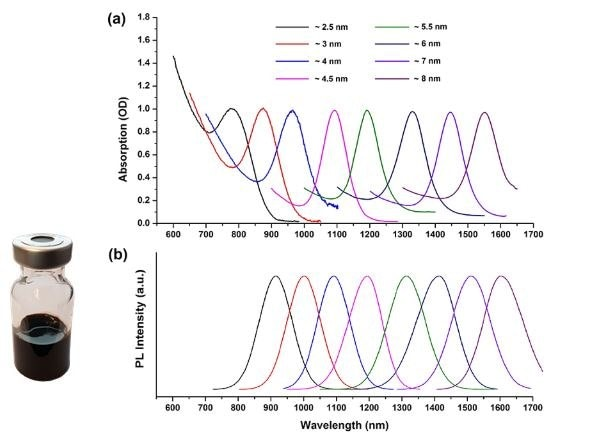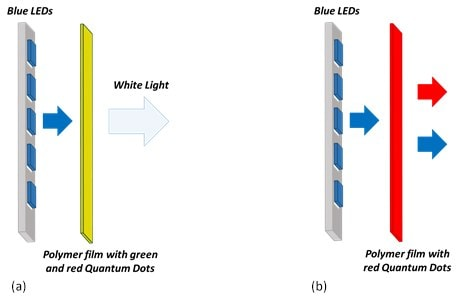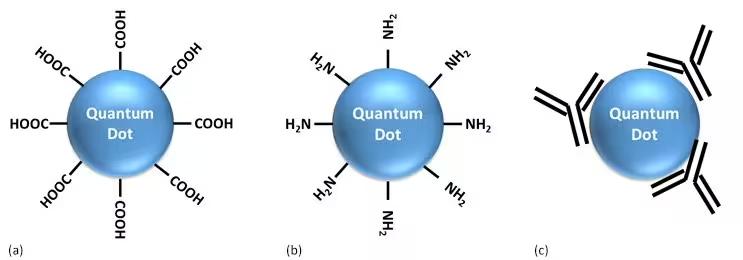Quantum Dots for Electronics and Energy Applications
WHAT ARE QUANTUM DOTS?
Quantum dots (QDs) are semiconductor materials at the nanoscale (~2-10 nm). Due to their small size, quantum dots exhibit quantum confinement effects as well as size-dependent electrical and optical properties. Since the discovery of cadmium-based QDs in the 1980s, a variety of cadmium- and non-cadmium-based QDs have been synthesized and studied. by tuning the shape and size of the QDs, the electrical and optical properties of QDs have been significantly improved and they have become an important class of materials, with applications ranging from light-emitting diodes (LEDs) to photovoltaics, photo-detectors, lasers and field-effect transistors. This technical article summarizes the properties of some new non-cadmium based QDs and the different applications of QDs.
?
PEROVSKITE QUANTUM DOTS
The recently discovered perovskite quantum dots with the generic molecular formula APbX3?[A = Cs, MA (methylamine), FA (formamidine), X = Cl, Br, I] have attracted great research interest. This is mainly due to their high photoluminescence quantum efficiency (PLQY, up to 95%) and narrow emission bandwidth (FWHM < 20-30 nm). perovskite quantum dots are considered to be one of the best alternatives to CdSe-based QDs. Depending on the size and composition of the halide, the emission wavelength of CsPbX3?QDSs can be tuned to cover the entire visible spectral region (from 450 nm to 700 nm). Figure 1?illustrates the color of various perovskite quantum dots under UV irradiation. CsPbCl3?QDs emit blue light, and as the Cl is partially replaced by Br, yielding the mixed halide encapsulated crystal CsPb(Cl/Br)3?(Fig. 2), the emission wavelength shifts to the green region of the visible spectrum. QDs with the composition CsPbBr3?emit green light, the emission wavelength of CsPb(Br/I)3?shifts to yellow, and the emission wavelength of CsPbI3?changes to red.
Among the various encapsulated QDs, those composed of CsPbX3?(X = Cl, Br) are the most stable, with emission wavelengths in the range of 450-510 nm, and these QDs are promising for photovoltaic applications because of their enhanced optical properties and chemical stability. These cadmium-free QDs with low lead content can be used in LEDs, LCD backlights and photodetectors.

Figure 1.?Colors of various perovskite quantum dots under UV illumination.

Figure 2.?Emission wavelengths of perovskite quantum dots CsPbX3?(X- Cl and Br)
PBS QUANTUM DOTS
The emission wavelength of lead sulfide quantum dots can be tuned between 900-1600 nm depending on their size (between 2.5 and 8 nm), which belongs to the infrared (IR) band of the electromagnetic spectrum. Typically, lead sulfide quantum dots have a broad absorption spectral range and a narrow fluorescence band (Fig. 3). These properties make PbS QDs suitable for use as light absorbers or infrared (IR) emitters in solar cells, photodetectors and infrared LEDs.
PbS quantum dots are of particular interest in solar photovoltaic applications because of their broad absorption spectrum (this extends from near infrared (NIR) to IR), high peak-to-valley ratio (>4), narrow band emission (FWHM < 100 nm) and high PLQY. These properties make PbS QDs suitable for use in tandem and multijunction solar cells for improving the efficiency of solar panels.

Figure 3. Absorption and emission wavelengths of ~4 nm PbS quantum dots.
QUANTUM DOT APPLICATIONS
Light Emitting Diodes (LEDs)
Quantum dots have promising applications in the light-emitting layer of LED devices. The narrow emission width (defined by the narrow half-height width (FWHM)) and the tunability of the emission wavelength make simple variations in size and composition of quantum dots attractive for LEDs. In addition, the possibility of fabricating optoelectronic devices with quantum dot-based LEDs through roll-to-roll printing, and the compatibility of most quantum dots with lightweight, flexible plastic substrates, opens up new applications for the fabrication of low-cost, large-area flexible devices. Visible quantum dot LED (Visible quantum dot -based LED) has the advantages of high color purity, high brightness, low power consumption, etc., and is considered to be a new generation of display technology after OLED displays.
Figure 4?shows the schematic diagram of a quantum dot-based LED device. First, a hole-transport layer (HTL) is spin-coated on indium tin oxide (ITO) with a glass or polymer substrate, and then quantum dots are prepared by the spin-coating method. For visible LEDs, quantum dots based on perovskite, CdSe or InP are used, and PbS quantum dots can be used for infrared LEDs. Deposition of quantum dots is followed by the deposition of an electron transport layer (ETL) and electrodes. Electrodes are usually prepared from metals, such as silver, gold or aluminum, and deposited by thermal evaporation systems. 1-6

Figure 4. Sketch of a quantum dot based LED structure
Lighting
A) Liquid crystal display (LCD) backlighting
In conventional LCDs, the backlight uses a white light source emitted by LEDs. However, in the new generation of LCDs, the backlight system consists of a blue light-emitting diode and a quantum dot filter. The filter contains green and red quantum dots that convert some of the blue light into green and red. Since the FWHM of red, green and blue light is narrow, the color gamut is wide, resulting in brighter images and higher contrast on LCDs. In addition, this arrangement significantly reduces energy consumption. QD-based filters can be designed in three configurations: "on-chip", "edge" and "surface". In the "on-chip" configuration, a mixture of green and red quantum dots is placed on top of the blue chip inside the LED package; in the "edge" configuration, the mixture is placed inside the glass guide near the LED in the package; and in the "surface" configuration, a polymer mixture is placed inside the glass guide near the LED in the package. surface" configuration, the mixture of quantum dots in a polymer film is integrated between the blue LED and the LCD matrix (Figure 5).7-11 perovskite, CdSe- and InP-based quantum dots emit in the visible range of the electromagnetic spectrum and can have a wide range of applications in backlighting.

Figure 5.?Schematics of Quantum Dots LCD backlighting in the “on-surface” configuration
B) Phosphors
QDs can be used as phosphors in applications such as white lighting or horticultural lighting (Figure 6). In these applications the blue LED, which is the most efficient and cheapest LED, is used as the main light source and similar to the LCD displays, QDs are used as phosphors to convert part of the blue light into another light. The possible configurations of lighting devices can be “on-chip” and “remote phosphors”. In the “on-chip” configuration the blend of QDs is placed on the top of the blue chip inside the LED package whereas in the “remote phosphor” configuration, the QDs blend in the polymer film is placed after the blue LEDs. For white lighting, the blend consists of green and red QDs. The main advantage of using QDs in white lighting is that it allows achieving a high color rendering index (CRI) and correlated color temperature (CCT). These parameters are measures of the ability of a light source to reproduce colors of various objects in comparison to a natural light source.
Red quantum dot polymer composites hold promise for horticultural LEDs for efficient greenhouse plant growth. Plant chlorophyll typically captures red (600-700 nm) and blue (400-500 nm) light waves most efficiently, with green light waves being reflected. Therefore, devices with blue LEDs and polymer composites with red quantum dots can deliver more photosynthetically effective radiation to plants without overheating them. The use of quantum dots can also effectively reduce energy costs.

Figure 6.?Cartoon of a QD based device for (a) white lighting and (b) horticultural lighting
Solar Cells
PbS quantum dots are particularly interesting for solar photovoltaic applications. PbS is a semiconducting material with a large Bohr exciton radius that enables quantum size effect tuning over a wide range of the solar spectrum. In addition, this material provides an avenue for single-material tandem and multi-junction solar cells through size-effect bandgap tunability. Figure 7?shows a schematic of a solar cell device with quantum dots. PbS quantum dots can have different bandgaps. Typically, P-type PbS quantum dot films are deposited layer by layer by spin-coating on an ETL/ITO/glass substrate layer, followed by deposition of HTLs consisting of Ag or Au and upper electrodes. Typically, electrode deposition is achieved by heating or electron beam evaporation. 12-16

Figure 7. Schematic of a quantum dot solar cell structure
PHOTODETECTORS
Quantum dots can be used in photodetectors that detect infrared and visible light. Infrared photodetectors have a wide range of applications in night vision cameras, atmospheric spectral gas detection, biomedical imaging, quality control and product inspection. Visible light photodetectors are used in image sensors for converting incident light into electronic signals. Quantum dots can also be used for surveillance, machine vision, industrial inspection, spectroscopic and fluorescent biomedical imaging. The advantage of using quantum dots is that they are easy to integrate with silicon electronics or flexible organic substrates. In addition, quantum dots can be deposited on prefabricated electrodes on substrates by simple methods such as inkjet printing, solution casting and low temperature evaporation. Optical absorption and emission spectra tunable through quantum size effects are another important advantage offered by quantum dots. Figure 8?depicts a schematic diagram of a quantum dot based photodetector. Typical preparation methods involve depositing electrodes onto a glass or ceramic substrate by evaporation and then spin-coating the substrate with a mixture of colloidal quantum dots or quantum dots in a polymer to form a solid quantum dot film or quantum dot-polymer composite between the electrodes.17-18?PbS quantum dots can be used in photodetectors for the IR spectrum, whereas quantum dots based on perovskite, CdSe and InP are are more often used in the UV-visible spectrum.

Figure 8. Schematic of a quantum dot photodetectors structure
BIOMEDICAL IMAGING
Quantum dots have several advantages as luminescent probes for biomedical imaging. These properties include high photostability, broad absorption spectra, large extinction coefficients, and tunable emission wavelengths. In addition, it has been shown that the surface of quantum dots can be modified to attach surface groups such as carboxyl groups and amines to bind to biomolecules such as antibodies, polysaccharides and peptides (Figure 9). Biocoupled quantum dots have been used as probes for DNA hybridization, receptor-mediated endocytosis, parasite metabolism monitoring, real-time visualization of tissue and cellular structures, and diagnostic applications.19-21

Figure 9.?Cartoons representing surface functionalized QDs: (a) carboxyl functionalized, (b) amine functionalized, (c) antibody conjugated
References
1.?Gong?X,?Yang?Z,?Walters?G,?Comin?R,?Ning?Z,?Beauregard?E,?Adinolfi?V,?Voznyy?O,?Sargent?EH.?2016.?Highly efficient quantum dot near-infrared light-emitting diodes.?Nature Photon.?10(4):253-257.?https://doi.org/10.1038/nphoton.2016.11
2. Supran?GJ,?Song?KW,?Hwang?GW,?Correa?RE,?Scherer?J,?Dauler?EA,?Shirasaki?Y,?Bawendi?MG,?Bulovi??V.?2015.?High-Performance Shortwave-Infrared Light-Emitting Devices Using Core-Shell (PbS-CdS) Colloidal Quantum Dots.?Adv. Mater..?27(8):1437-1442.?https://doi.org/10.1002/adma.201404636
3.?Veldhuis?SA,?Boix?PP,?Yantara?N,?Li?M,?Sum?TC,?Mathews?N,?Mhaisalkar?SG.?2016.?Perovskite Materials for Light-Emitting Diodes and Lasers.?Adv. Mater..?28(32):6804-6834.?https://doi.org/10.1002/adma.201600669
4.?Song?J,?Li?J,?Li?X,?Xu?L,?Dong?Y,?Zeng?H.?2015.?Quantum Dot Light-Emitting Diodes Based on Inorganic Perovskite Cesium Lead Halides (CsPbX3).?Adv. Mater..?27(44):7162-7167.?https://doi.org/10.1002/adma.201502567
5.?Dai?X,?Zhang?Z,?Jin?Y,?Niu?Y,?Cao?H,?Liang?X,?Chen?L,?Wang?J,?Peng?X.?2014.?Solution-processed, high-performance light-emitting diodes based on quantum dots.?Nature.?515(7525):96-99.?https://doi.org/10.1038/nature13829
6. Chen?O,?Zhao?J,?Chauhan?VP,?Cui?J,?Wong?C,?Harris?DK,?Wei?H,?Han?H,?Fukumura?D,?Jain?RK,?et al.?2013.?Compact high-quality CdSe?CdS core?shell nanocrystals with narrow emission linewidths?and?suppressed blinking.?Nature Mater.?12(5):445-451.?https://doi.org/10.1038/nmat3539
7.?Protesescu?L,?Yakunin?S,?Bodnarchuk?MI,?Krieg?F,?Caputo?R,?Hendon?CH,?Yang?RX,?Walsh?A,?Kovalenko?MV.?2015.?Nanocrystals of Cesium Lead Halide Perovskites (CsPbX3, X = Cl, Br, and I): Novel Optoelectronic Materials Showing Bright Emission with Wide Color Gamut.?Nano Lett..?15(6):3692-3696.?https://doi.org/10.1021/nl5048779
8.?Li?X,?Wu?Y,?Zhang?S,?Cai?B,?Gu?Y,?Song?J,?Zeng?H.?2016.?CsPbX3Quantum Dots for Lighting and Displays: Room-Temperature Synthesis, Photoluminescence Superiorities, Underlying Origins and White Light-Emitting Diodes.?Adv. Funct. Mater..?26(15):2435-2445.?https://doi.org/10.1002/adfm.201600109
9.?Kim?T,?Jun?S,?Cho?K,?Choi?BL,?Jang?E.?2013.?Bright and stable quantum dots and their applications in full-color displays.?MRS Bull..?38(9):712-720.?https://doi.org/10.1557/mrs.2013.184
10.?Huang?B,?Xu?R,?Zhuo?N,?Zhang?L,?Wang?H,?Cui?Y,?Zhang?J.?2016.??Giant? red and green core/shell quantum dots with high color purity and photostability.?Superlattices and Microstructures.?91201-207.?https://doi.org/10.1016/j.spmi.2016.01.015
11.?Supran?GJ,?Shirasaki?Y,?Song?KW,?Caruge?J,?Kazlas?PT,?Coe-Sullivan?S,?Andrew?TL,?Bawendi?MG,?Bulovi??V.?2013.?QLEDs for displays and solid-state lighting.?MRS Bull..?38(9):703-711.?https://doi.org/10.1557/mrs.2013.181
12.?Lan?X,?Voznyy?O,?Kiani?A,?García de Arquer?FP,?Abbas?AS,?Kim?G,?Liu?M,?Yang?Z,?Walters?G,?Xu?J,?et al.?2016.?Passivation Using Molecular Halides Increases Quantum Dot Solar Cell Performance.?Adv. Mater..?28(2):299-304.?https://doi.org/10.1002/adma.201503657
13.?Ning?Z,?Voznyy?O,?Pan?J,?Hoogland?S,?Adinolfi?V,?Xu?J,?Li?M,?Kirmani?AR,?Sun?J,?Minor?J,?et al.?2014.?Air-stable n-type colloidal quantum dot solids.?Nature Mater.?13(8):822-828.?https://doi.org/10.1038/nmat4007
14.?Chuang?CM,?Brown?PR,?Bulovi??V,?Bawendi?MG.?2014.?Improved performance and stability in quantum?dot solar cells through band alignment?engineering.?Nature Mater.?13(8):796-801.?https://doi.org/10.1038/nmat3984
15.?Pan?J,?El-Ballouli?AO,?Rollny?L,?Voznyy?O,?Burlakov?VM,?Goriely?A,?Sargent?EH,?Bakr?OM.?2013.?Automated Synthesis of Photovoltaic-Quality Colloidal Quantum Dots Using Separate Nucleation and Growth Stages.?ACS Nano.?7(11):10158-10166.?https://doi.org/10.1021/nn404397d
16.?Wang?X,?Koleilat?GI,?Tang?J,?Liu?H,?Kramer?IJ,?Debnath?R,?Brzozowski?L,?Barkhouse?DAR,?Levina?L,?Hoogland?S,?et al.?2011.?Tandem colloidal quantum dot solar cells employing a graded recombination layer.?Nature Photon.?5(8):480-484.?https://doi.org/10.1038/nphoton.2011.123
17.?Konstantatos?G,?Sargent?EH.?2013.?Colloidal Quantum Dot Optoelectronics and Photovoltaics.?https://doi.org/10.1017/cbo9781139022750
18.?Konstantatos?G,?Sargent?EH.?2010.?Nanostructured materials for photon detection.?Nature Nanotech.?5(6):391-400.?https://doi.org/10.1038/nnano.2010.78
19.?Michalet?X.?2005.?Quantum Dots for Live Cells, in Vivo Imaging, and Diagnostics.?Science.?307(5709):538-544.?https://doi.org/10.1126/science.1104274
20.?Jamieson?T,?Bakhshi?R,?Petrova?D,?Pocock?R,?Imani?M,?Seifalian?AM.?2007.?Biological applications of quantum dots.?Biomaterials.?28(31):4717 4732.?https://doi.org/10.1016/j.biomaterials.2007.07.014
21.?Yu?WW,?Chang?E,?Drezek?R,?Colvin?VL.?2006.?Water-soluble quantum dots for biomedical applications.?Biochemical and Biophysical Research Communications.?348(3):781-786.?https://doi.org/10.1016/j.bbrc.2006.07.160
 首页
首页 400-620-6333
400-620-6333



 危险品化学品经营许可证(带存储)
危险品化学品经营许可证(带存储)